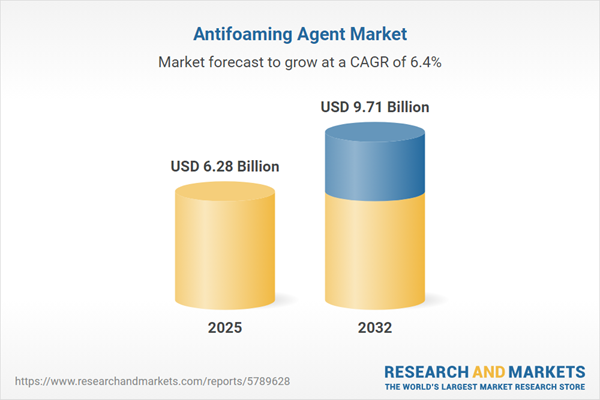Speak directly to the analyst to clarify any post sales queries you may have.
In a rapidly shifting industrial landscape, efficient antifoaming agent strategies have become essential for senior leaders committed to maintaining stable operations and regulatory compliance. The continual integration of advanced technologies and increased environmental expectations highlight the importance of informed procurement and deployment choices in the antifoaming agent sector.
Market Snapshot: Antifoaming Agent Market Growth and Expansion
The antifoaming agent market continues to expand, advancing from USD 5.90 billion in 2024 to USD 6.28 billion in 2025, with a projected value of USD 9.71 billion by 2032. This growth, underpinned by a robust CAGR of 6.42%, is primarily sustained by ongoing industrialization, the need for upgraded purification protocols, and continual innovation in antifoaming technologies. Industries ranging from water treatment and food processing to specialized manufacturing increasingly demand high-performance and application-specific solutions, intensifying competition and driving product development. Major vendors are broadening product offerings to suit precise sectoral needs, while enhanced compliance frameworks and a greater push for operational quality further shape market dynamics.
Scope & Segmentation: Comprehensive Antifoaming Agent Market Assessment
A clear segmentation approach enables decision-makers to identify targeted commercial opportunities and adapt procurement strategies for various operational contexts. This assessment spans key types, applications, forms, channels, regions, and companies, reflecting the multi-faceted dynamics of today’s antifoaming agent market.
- Type: Non-silicone-based antifoaming agents (fatty acids, mineral oil, phospholipid, and polymer) as well as silicone-based variants (linear and modified polydimethylsiloxane) support selection tailored to diverse industry needs.
- Application: Utilization spans food and beverage processing, oil and gas operations, industrial coatings, pharmaceuticals, pulp and paper production, and water treatment, where assured foam control and reliability are critical.
- Form: Agents are available as emulsions, liquids, and powders, each facilitating different storage conditions, dosing techniques, and compatibility considerations.
- Distribution Channel: Direct sales fulfill the requirements of large industrial customers, while specialist distributors and digital channels serve small and mid-size enterprises to ensure supply consistency and procurement flexibility.
- Regions: The market covers the Americas, Europe, Middle East, Africa, and Asia-Pacific, including significant economies such as the United States, China, India, Germany, Japan, Australia, Saudi Arabia, and Brazil, each influencing procurement and application strategies through their regulatory and infrastructural nuances.
- Companies: Industry leaders—including Dow Inc., Evonik Industries AG, BASF SE, Wacker Chemie AG, Croda International plc, Clariant AG, Nouryon Holding B.V., and Solvay S.A.—drive technology advancement and global supply chain resilience through continued innovation.
Key Takeaways for Senior Decision-Makers
- Antifoaming solutions are fundamental for maintaining production efficiency and product quality in industries with elevated regulatory oversight and consistency requirements.
- Heightened sustainability demand prompts the adoption of biodegradable and plant-derived formulations, supporting broader compliance objectives and market acceptance in multiple regions.
- Robust sourcing and contract management aid in mitigating supply disruptions, protecting organizations from raw material market fluctuations and unpredictable trade conditions.
- Leading vendors offer enhanced technical support and digital tools, resulting in improved after-sales service and greater operational reliability for buyers.
- Technical innovation in silicone-based and emulsified products enables tailored performance improvements, particularly for specialized and high-throughput production environments.
- Regional differences regarding regulation, distribution practices, and infrastructure require localized product adaptation and strategic partnerships to ensure successful deployment and compliance.
Tariff Impact: Navigating New U.S. Trade Policy Dynamics
Forthcoming U.S. tariffs in 2025 will alter the cost landscape and sourcing structure for antifoaming agent producers and buyers. Forward-thinking organizations are strengthening domestic supply chains, diversifying procurement pathways, and securing longer-term contracts to safeguard access and reduce exposure to evolving international trade dynamics.
Methodology & Data Sources
This market insight is built on direct interviews with chemical engineers, buyers, and product specialists. Findings are verified through technical publications, patent analysis, and regulatory review, ensuring that all data and recommendations reflect practical, actionable intelligence for B2B environments.
Why This Report Matters
- Empowers decision-makers to adapt procurement and compliance strategies amid emergent global and regional shifts impacting the antifoaming agent market.
- Helps organizations enhance resilience against supply interruptions, enabling steady progress in sustainability and operational effectiveness based on reliable market evidence.
- Facilitates transparent vendor evaluations, more strategic partnerships, and better-informed investment decisions for sustained business advantage.
Conclusion
This report offers actionable guidance for senior leaders to improve organizational agility, deepen compliance readiness, and optimize supplier engagement in the evolving antifoaming agent market.
Additional Product Information:
- Purchase of this report includes 1 year online access with quarterly updates.
- This report can be updated on request. Please contact our Customer Experience team using the Ask a Question widget on our website.
Table of Contents
3. Executive Summary
4. Market Overview
7. Cumulative Impact of Artificial Intelligence 2025
List of Figures
Samples

LOADING...
Companies Mentioned
The key companies profiled in this Antifoaming Agent market report include:- Dow Inc.
- Evonik Industries AG
- BASF SE
- Wacker Chemie AG
- Croda International plc
- Clariant AG
- Nouryon Holding B.V.
- Solvay S.A.
Table Information
| Report Attribute | Details |
|---|---|
| No. of Pages | 188 |
| Published | October 2025 |
| Forecast Period | 2025 - 2032 |
| Estimated Market Value ( USD | $ 6.28 Billion |
| Forecasted Market Value ( USD | $ 9.71 Billion |
| Compound Annual Growth Rate | 6.4% |
| Regions Covered | Global |
| No. of Companies Mentioned | 9 |









